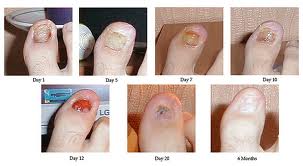Posts Tagged ‘nail bed’
Removing All of or a Portion of Your Nail to Treat Nail Fungus – Is it Effective?
Removing All of or a Portion of Your Nail
to Treat Nail Fungus – Is it Effective?
 No one really knows. Little to no research has been done on removing all or part of the nail to treat a nail fungus infection. That’s because it’s sort of a last resort treatment for dealing with onychomycosis. However if you are unable to take any of the oral medications suggested for treating onychomycosis and if none of the topical solutions are effective, or if you have tried treating your nail fungus in several ways and none of them have been effective, then surgery may be an option.
No one really knows. Little to no research has been done on removing all or part of the nail to treat a nail fungus infection. That’s because it’s sort of a last resort treatment for dealing with onychomycosis. However if you are unable to take any of the oral medications suggested for treating onychomycosis and if none of the topical solutions are effective, or if you have tried treating your nail fungus in several ways and none of them have been effective, then surgery may be an option.
Another thing to consider is if you continue to experience recurring nail fungus infections, you might need to make some dietary changes and/or do a medical cleanse to get the possible sources of infection out of your system.
How does it work?
Your options for having your nail removed are as follows:
- Complete removal – known as avulsion
- Partial removal – known as debridement
There are also two options for having these procedures done:
- Surgery – Your doctor will numb the skin around and under your nail with a local anesthetic, either topical or a shot. Then a tool will be used to separate your nail from the surrounding skin and nail bed. (Your nail bed is the skin underneath your nail. This is most commonly where a nail fungus hides and breeds.) Once the nail has been removed your nail bed and surrounding skin should heal in 2-3 weeks.
- Ointment – Your doctor will cover the skin around your infected nail to protect it (similar to taping a window or door while painting.) Then an ointment will be put on the infected nail. The infected nail is covered with a plastic dressing, which will need to be kept dry. After a week to a week and a half, your nail should be soft enough to be removed by your doctor. The exposed nail bed and surrounding skin should heal in 2-3 weeks.
After you have undergone either of these procedures, your doctor will probably recommend taking an oral antifungal medication, or putting a topical ointment on the exposed nail bed to deliver the medicine directly to the affected area.
A fingernail, once the infected portion is removed should grow back healthy within about 6 months. A toenail may take up to 18 months to grow back.
If infection continues after this procedure, your doctor may recommend completely removing the nail again and putting a chemical on the cuticle (the soft layer of skin at the base of your nail) to prevent your nail from growing back.
Does it help?
Again, no one really knows as no one has put the time and research into the effects of removing part or all of the nail to cure onychomycosis.
So far, there is one reliable study that compared taking oral antifungal medication against other types of treatment, including removing part of the nail and putting a topical antifungal medication directly on the nail bed. The results were that people who chose the oral antifungal medication were happier with their treatment outcome than people who had part of their nail removed or who used any sort of topical remedy.
Possible Side Effects?
Once your nail has been removed from the nail bed, you will need to keep it clean and dry to prevent possible further infection of the area. Your doctor may also recommend using an antibiotic cream to ensure that everything heals well and stays healthy.
Another possible problem is that the side or corner of your nail could re-grow into the skin surrounding your toe. This is referred to as an ingrown toe nail. Mild symptoms of an ingrown toenail can be treated by soaking your foot in warm salt water and then propping the ingrown porting of your toenail to encourage it to grow above the skin. A more severe ingrown toenail will require you to return to your doctor for treatment.
Easily Applied Home Nail Fungus Remedies
Easily Applied Home Nail Fungus Remedies
 Having unattractive toenails is embarrassing and even humiliating. There are many ways to solve this incredibly common problem.
Having unattractive toenails is embarrassing and even humiliating. There are many ways to solve this incredibly common problem.
How Does My Nail Become Infected?
Toenails come into contact with microorganisms that get onto the skin, the nail sheath and underneath the nail to the nail bed. Any and all of these places can easily become a hotbed (literally) for infection. Once you have contracted a fungal infection, it can be very difficult to cure.
As these microorganisms are fungal spores, they thrive in places that have no light and high humidity. This makes the feet very susceptible to infection because we are all accustomed to wearing shoes. Especially because many people wear the same pair of shoes day in and day out, not allowing time for them to dry and air between wearings.
Trimming your toenails too close to the skin can cause accidental cuts, providing another entry point for these fungal spores.
Shoes that fit to tightly can also be a cause of toenail fungus infection as they leave no room for your feet to breath and they can cause the breakdown of the nail where they rub, leaving an opening for the fungus to invade.
Standard Symptoms of Nail Fungus Infection
Here are some very simple ways to recognize a toenail fungus infection:
- A discoloration of the toenail, white to yellow
- The nail becomes thick and disfigured
- A stinging pain from under and around the nail
- Brown or black spots developing on the nail
- Parts of the nail crumble or flake off
- A foul odor coming from the nail
- Oozing pus from around the nail
- Toenail falling off entirely
Recommended Home Remedies for Fungal Nail Infection
The faster you catch a fungal nail infection, the easier it is to get rid of it. The early stages can be treated with any of the remedies listed below:
- ClearFungus – This is the leading natural remedy for curing toenail fungus. This is considered more of a natural product anti-fungal treatment than a home remedy as it is specially formulated to kill toenail fungus and promote new nail growth.
- Vicks VapoRub – Although no one quite understands why, Vicks VapoRub seems to prove very effective at stopping the growth of fungal infection. It does not kill the fungus but does inhibit growth, which can encourage healthy nail growth until the infection has been trimmed entirely away. No studies have been done on this but many people swear by it.
- Hydrogen Peroxide, Listerine and Rubbing Alcohol – Combined or separately, all of these chemicals have been shown to have some effect on nail fungus as they all posses antiseptic properties. Soak your toenails in your choice of these solutions (again, combined or separately) for twenty minutes, two times a day.
- Tea Tree Oil – This is a powerful essential oil that contains antiseptic and antifungal components. Wash and thoroughly dry the foot, then rub the affected nail(s) and surrounding skin with Tea Tree Oil twice a day.
- Vinegar – Soaking your toes in a solution of equal parts vinegar and water in a large tub or bowl for 20-30 minutes, then washing and thoroughly drying your feet until the infection has cleared.
These remedies are good for stopping the infection early on. If you follow these instructions closely and stick to the regular process, you should be able to clear up your infection by yourself. If your symptoms are bad to begin with, or if they worsen, seeking the help of a medical professional will become necessary.